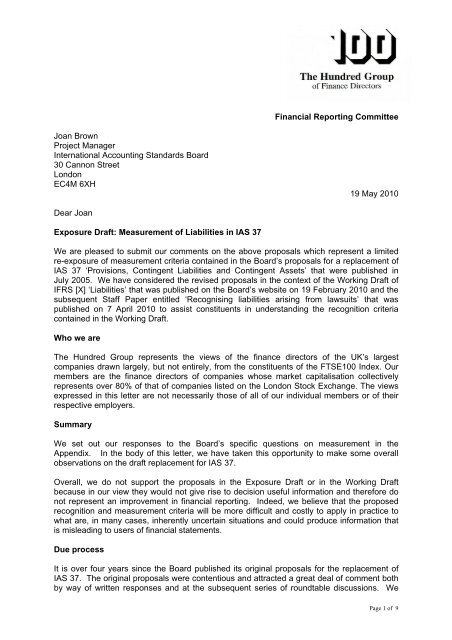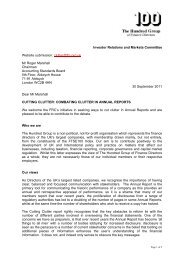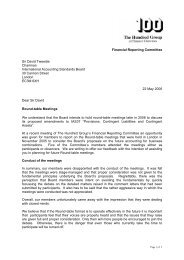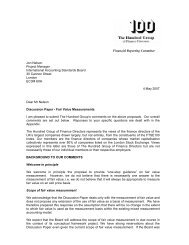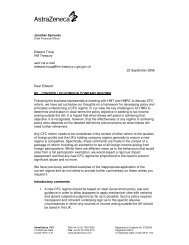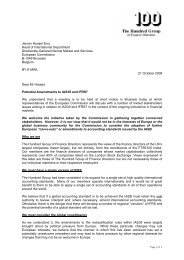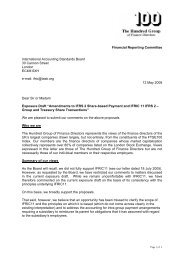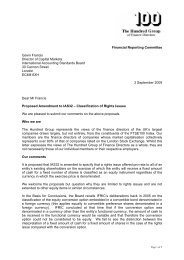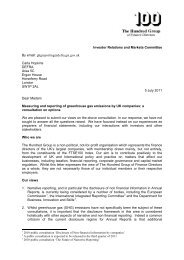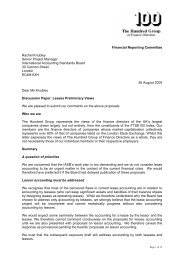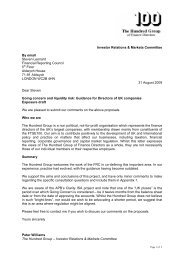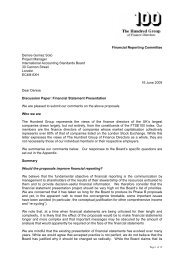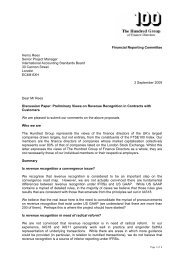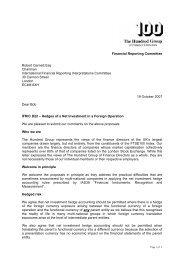Financial Reporting Committee Joan Brown Project Manager ...
Financial Reporting Committee Joan Brown Project Manager ...
Financial Reporting Committee Joan Brown Project Manager ...
You also want an ePaper? Increase the reach of your titles
YUMPU automatically turns print PDFs into web optimized ePapers that Google loves.
<strong>Joan</strong> <strong>Brown</strong><br />
<strong>Project</strong> <strong>Manager</strong><br />
International Accounting Standards Board<br />
30 Cannon Street<br />
London<br />
EC4M 6XH<br />
Dear <strong>Joan</strong><br />
Exposure Draft: Measurement of Liabilities in IAS 37<br />
<strong>Financial</strong> <strong>Reporting</strong> <strong>Committee</strong><br />
19 May 2010<br />
We are pleased to submit our comments on the above proposals which represent a limited<br />
re-exposure of measurement criteria contained in the Board’s proposals for a replacement of<br />
IAS 37 ‘Provisions, Contingent Liabilities and Contingent Assets’ that were published in<br />
July 2005. We have considered the revised proposals in the context of the Working Draft of<br />
IFRS [X] ‘Liabilities’ that was published on the Board’s website on 19 February 2010 and the<br />
subsequent Staff Paper entitled ‘Recognising liabilities arising from lawsuits’ that was<br />
published on 7 April 2010 to assist constituents in understanding the recognition criteria<br />
contained in the Working Draft.<br />
Who we are<br />
The Hundred Group represents the views of the finance directors of the UK’s largest<br />
companies drawn largely, but not entirely, from the constituents of the FTSE100 Index. Our<br />
members are the finance directors of companies whose market capitalisation collectively<br />
represents over 80% of that of companies listed on the London Stock Exchange. The views<br />
expressed in this letter are not necessarily those of all of our individual members or of their<br />
respective employers.<br />
Summary<br />
We set out our responses to the Board’s specific questions on measurement in the<br />
Appendix. In the body of this letter, we have taken this opportunity to make some overall<br />
observations on the draft replacement for IAS 37.<br />
Overall, we do not support the proposals in the Exposure Draft or in the Working Draft<br />
because in our view they would not give rise to decision useful information and therefore do<br />
not represent an improvement in financial reporting. Indeed, we believe that the proposed<br />
recognition and measurement criteria will be more difficult and costly to apply in practice to<br />
what are, in many cases, inherently uncertain situations and could produce information that<br />
is misleading to users of financial statements.<br />
Due process<br />
It is over four years since the Board published its original proposals for the replacement of<br />
IAS 37. The original proposals were contentious and attracted a great deal of comment both<br />
by way of written responses and at the subsequent series of roundtable discussions. We<br />
Page 1 of 9
ourselves were critical of the proposals both by way of our written comments (see our letter<br />
to the then <strong>Project</strong> <strong>Manager</strong>, Henry Rees, dated 28 October 2005) and our contribution to the<br />
roundtables held in London in November 2005.<br />
While the Board has re-deliberated the entire draft standard, it has re-exposed for comment<br />
only the aspects of its proposals that deal with the measurement of liabilities. It has<br />
expressly not invited comments on the other aspects of its proposals. Indeed, the Working<br />
Draft of the standard is incomplete because it does not include either the basis for the<br />
Board’s conclusions or any illustrative examples.<br />
We believe that the complete draft standard should be re-exposed for comment by<br />
constituents. It took the Board four years to complete its re-deliberation of the original<br />
proposals and, as might be expected after all that time, significant changes have been made<br />
to them. Constituents should be given the opportunity to re-consider the revised proposals in<br />
their entirety, particularly because the aspects of the draft standard that deal with<br />
measurement are so closely-related to those that deal with recognition. We note that two<br />
Board members share our view for similar reasons.<br />
We are disappointed that the Board seems to have disregarded the views of its constituents.<br />
At a time when the Board’s due process is under scrutiny, we believe that it was ill-advised<br />
not to have sought comments from constituents on revised proposals that are likely to affect<br />
all of them.<br />
Undue haste<br />
We do not understand the Board’s sudden haste to finalise the replacement of IAS 37.<br />
The Board claims that the main aims of the project are to align the criteria in IAS 37 for<br />
recognising a liability with those in other IFRSs (in particular, IFRS 3 (Revised 2008)<br />
‘Business Combinations), to eliminate some differences between IAS 37 and US GAAP (in<br />
particular, the timing of recognition of restructuring costs) and to clarify the measurement of<br />
liabilities in IAS 37 that are vague and make it difficult for capital providers to compare<br />
financial statements.<br />
We do not consider these to be significant failings of IAS 37. Firstly, differences exist<br />
between other standards and IFRS 3 (in particular, with regard to the recognition of<br />
intangible assets) and this, in our view, is appropriate because, with some exceptions,<br />
IFRS 3 requires that the assets and liabilities of an acquired business are initially measured<br />
at fair value whereas this is not usually the case other than in a business combination.<br />
Secondly, replacement of IAS 37 is not a matter that is covered by the convergence agenda<br />
and, while the proposals may align the recognition of restructuring costs, they will actually<br />
create further differences between IFRSs and US GAAP. Finally, we are not aware that<br />
capital providers have expressed significant concerns that inconsistent measurement of<br />
liabilities is making it difficult for them to compare financial statements.<br />
We therefore question the need to progress with this project when there are many more<br />
pressing issues to be dealt with over the next year or so.<br />
Lack of clarity<br />
We found many aspects of the Working Draft to be unclear and difficult to understand. We<br />
believe that understandability will be a particular issue for those of the Board’s constituents<br />
whose first language is not English.<br />
We suspect that the Staff also consider the Working Draft to be unclear because they found<br />
it necessary to issue a paper to assist constituents in understanding the recognition criteria<br />
Page 2 of 9
efore commenting on the revised measurement proposals. While we found the Staff’s<br />
paper to be useful, we note that it is not an official pronouncement of the Board and we do<br />
not think that issuing unofficial papers is an appropriate way of addressing the uncertainties<br />
that exist in a set of official proposals.<br />
Definition of a liability<br />
Under IAS 37, an entity should recognise a liability if it has a present obligation, it is probable<br />
(more likely than not) that an outflow of resources will be required to settle the obligation and<br />
a reliable estimate can be made of the amount of the obligation.<br />
The Board intends to remove the probability criterion such that all present obligations would<br />
be recognised that can be measured reliably.<br />
The ‘Framework for the Preparation and Presentation of <strong>Financial</strong> Statements’ states that a<br />
liability should be recognised only if it is probable that an outflow of resources will result from<br />
the settlement of the obligation. Clearly, then, the proposed recognition criteria conflict with<br />
the Framework because the probability criterion has been removed. We do not believe that<br />
the Board should develop definitions in individual standards that are inconsistent with the<br />
definitions contained in the Framework. If the Board wishes to change the definition of a<br />
liability it should subject its proposal to the appropriate due process in the context of the<br />
Framework.<br />
Moreover, we sense that there is a difference of opinion between the Board and the Staff as<br />
to whether the proposed definition of a liability is inconsistent with the Framework.<br />
Paragraph 22 of the Working Draft states “The Framework defines a liability as a present<br />
obligation ‘the settlement of which is expected to result in an outflow from the entity of<br />
resources embodying economic benefits’. This part of the definition does not require a<br />
particular degree of certainty that an outflow of resources will occur. Present obligations that<br />
are capable of resulting in an outflow of resources meet the definition of a liability even if the<br />
likelihood of an outflow is low.” On the other hand, paragraph 27 the Staff paper states “The<br />
[Framework] states that liabilities should be recognised only if it is probable that an outflow of<br />
resources will result from the settlement of the obligation. Consequently removing [the<br />
probability criterion] from IAS 37 will create tensions with the Framework”. Paragraph 28 of<br />
the Staff paper continues “The IASB regards aligning IAS 37 with other IFRSs – so that all<br />
liabilities are recognised – as more important than preserving consistency with all aspects of<br />
the existing 20-year old Framework.” In other words, while the Board sees no conflict with<br />
the Framework, the Staff believe that there is a conflict (albeit one which the IASB can live<br />
with in the interests of consistency with other IFRSs).<br />
While on the subject of the Framework, we consider that the proposed inclusion of a profit<br />
margin in the measurement of a liability where the obligation will be settled by provision of a<br />
service conflicts with the definition of a liability contained in the Framework because the profit<br />
margin does not reflect an outflow of resources.<br />
Over the years, we have been consistent in urging the Board to give priority to the revision of<br />
the Framework over the development of individual standards. We believe that this<br />
inconsistency in the definition of a liability vindicates our concern that otherwise strains will<br />
develop between the Framework and individual standards with the result that the framework<br />
will eventually have to be written to fit the standards rather than the standards based upon the<br />
framework. We find this difficult to reconcile with the Board’s view that it is developing<br />
principles-based accounting standards.<br />
Page 3 of 9
Application to legal claims<br />
We welcome the Staff paper because constituents are perhaps most likely to encounter<br />
difficulties in applying the proposed recognition criteria in the context of legal claims.<br />
The Staff contend that removing the probability criterion would not require entities to<br />
recognise liabilities for all legal claims because the claim might not satisfy the other<br />
recognition criteria. In particular, the existence of a legal claim does not necessarily mean<br />
that the entity has a present obligation because this will depend on whether the claim is valid.<br />
The Staff consider that many preparers of financial statements focus on the probability<br />
criterion when judging whether to recognise a liability for a legal claim and, without this<br />
criterion, the focus would shift from predicting the likely outcome to judging whether the entity<br />
has an obligation.<br />
The Staff conclude that the change in focus would not affect the recognition decision<br />
because the likely outcome and the existence of an obligation both depend on the same<br />
factor, i.e. the strength of the claim against the entity. If a realistic assessment of the<br />
evidence leads to a conclusion that the claim has no merit, the entity would not recognise a<br />
liability but would disclose information about the case similar to the information that it would<br />
disclose for a contingent liability in accordance with IAS 37.<br />
While the Staff’s explanation is more coherent than the Working Draft, we continue to have<br />
strong reservations about the removal of the probability criterion from the definition of a<br />
liability. In practice, it is often difficult to gather a body of evidence to support an opinion that<br />
a legal claim has no validity. We have found that the probability criterion provides a useful<br />
practical threshold to determine whether a liability should be recognised without having to<br />
reach a definitive conclusion as to whether the claim has validity.<br />
We believe that the eventual guidance on the recognition of legal claims should be extended<br />
to other claims.<br />
Measurement<br />
We set out our comments on the proposed measurement criteria in the Appendix. In<br />
summary, we believe that the amount recognised in respect of a liability should be the best<br />
estimate of the outflow of cash or other resources that the entity expects to incur in<br />
discharging the obligation. We therefore disagree with the proposed measurement criteria in<br />
a number of respects. Moreover, we note that six Board members share some of our<br />
concerns.<br />
Tax liabilities<br />
In March 2009, the Board published an Exposure Draft ‘Income Tax’ which, among other<br />
things, proposed that the expected value approach should be used in measuring uncertain<br />
tax positions. We strongly opposed the proposals.<br />
In our letter to the <strong>Project</strong> <strong>Manager</strong>, Anne McGeachin, dated 22 September 2009, we<br />
commented “We are concerned that the Board’s proposals on the measurement of uncertain<br />
tax positions may be seriously prejudicial to the interests of capital providers. In particular,<br />
where the expected value approach leads to the recognition of a provision that is higher than<br />
the outcome that is considered most likely by management, the entity’s position in<br />
negotiating with the tax authorities could be undermined”.<br />
While the Board has dropped its proposals on income tax, it is proposing that the expected<br />
value approach should be used in measuring all liabilities that are within the scope of the<br />
replacement for IAS37. While tax liabilities within the scope of IAS 12 ‘Income Taxes’ are<br />
Page 4 of 9
outside the scope of the Working Draft, we are concerned that if the expected value<br />
approach is accepted for measuring liabilities generally, the Board will feel justified in<br />
introducing it in its promised ‘limited scope’ amendment to IAS 12 on the grounds of<br />
ensuring consistency between IFRSs.<br />
The way forward<br />
We strongly recommend to the Board that it defers this project until after 2011, which will<br />
allow time for a more fundamental review of its proposals to be undertaken. We hope that<br />
this would be conducted after the definition of a liability has been reviewed in the context of<br />
the Framework.<br />
We caution the Board that there continues to be widespread opposition to the proposals.<br />
We believe that, if the Board presses ahead with the proposals in their current form, the<br />
eventual replacement for IAS 37 may fail to be endorsed for use in the European Union. We<br />
feel sure that the Board appreciates the implications of that for the entire convergence<br />
project. We do not believe that it is worth taking that risk to replace a standard that is not in<br />
need of urgent reform.<br />
Please feel free to contact me if you wish to discuss our comments on the proposals.<br />
Yours sincerely<br />
Chris Lucas<br />
Chairman<br />
The Hundred Group - <strong>Financial</strong> <strong>Reporting</strong> <strong>Committee</strong><br />
Page 5 of 9
Question 1 – Overall requirements<br />
APPENDIX<br />
The proposed measurement requirements are set out in paragraphs 36A-36F.<br />
Paragraphs BC2-BC11 of the Basis for Conclusions explain the Board’s reasons for<br />
these proposals.<br />
Do you support the requirements proposed in paragraphs 36A-36F? If not, with which<br />
paragraphs do you disagree, and why?<br />
We believe that the amount recognised in respect of a liability should be the best estimate of<br />
the outflow of cash or other resources that the entity expects to incur in discharging the<br />
obligation. We therefore disagree with the proposed measurement criteria in a number of<br />
respects.<br />
The basic principle<br />
Paragraph 36A states that an entity should measure a liability at the amount that it would<br />
rationally pay to be relieved of the present obligation. Paragraph 36B defines that amount as<br />
the lowest of:<br />
a) the present value of the resources required to fulfil the obligation measured in<br />
accordance with Appendix B;<br />
b) the amount that the entity would have to pay to cancel the obligation; and<br />
c) the amount that the entity would have to pay to transfer the obligation to a third party.<br />
We disagree with the basic principle because we believe that the estimate should be based<br />
on the way in which management intends to discharge the obligation, not on an assessment<br />
of what management would pay to discharge the obligation in a number of hypothetical<br />
scenarios. We believe that an approach based on management’s intention would provide the<br />
most meaningful information to users of financial statements because it would produce a<br />
best estimate of the actual outflow of resources.<br />
While the proposed approach may be attractive in theory, in reality there are a number of<br />
reasons why an entity may not make what is apparently the most ‘rational’ choice in<br />
discharging an obligation (in particular, an entity may wish to retain control over discharging<br />
an obligation to avoid reputational risk even where the rational choice would be to transfer<br />
the obligation to a third party). Indeed, as the Board itself acknowledges in paragraph 36C,<br />
the entity may simply be unable to cancel or transfer an obligation even where this may<br />
apparently be the most rational thing to do.<br />
We acknowledge that paragraph 37 of IAS 37 also refers to the amount that an entity would<br />
“rationally pay” to settle or transfer the obligation. However, in our experience, current<br />
practice is to measure an obligation based on the way in which management actually intends<br />
to discharge the obligation. At a time when many users of financial statements are urging<br />
the Board to reduce complexity in financial statements, these proposals seem to be adding<br />
complexity with no apparent benefit to the users.<br />
Page 6 of 9
We have concerns about the way in which the cost of fulfilling the obligation would be<br />
measured in accordance with Appendix B. We discuss those concerns in our response to<br />
Question 2.<br />
Finally, if paragraph 36B is retained, we would suggest that in sub-paragraph (b) the word<br />
‘cancel’ should be replaced with the word ‘settle’ as we believe that this more accurately<br />
reflects the Board’s intentions (the obligation will not cease to exist, but will be discharged by<br />
settlement) and is less likely to be misunderstood by users.<br />
Expected value<br />
We appreciate that the Board does not intend to revisit its proposed application of the<br />
expected value approach to the measurement of obligations. However, we feel duty bound<br />
to reiterate our concern that the expected value approach is not appropriate in all<br />
circumstances. Consequently, there will be many situations in which the expected value<br />
approach will be difficult to apply in practice and will give rise to potentially misleading<br />
results.<br />
When it comes to making the best estimate of the cash outflows required to settle an<br />
obligation, we do not agree with the Board’s view that ‘one size fits all’. We believe that while<br />
expected value may be the most appropriate in some circumstances, the most likely outcome<br />
will be the most appropriate in others. We are therefore content with the approach to<br />
measurement prescribed by IAS 37 which requires the use of the expected value approach<br />
when measuring the obligation associated with a large population of items but considers that<br />
where a single item is being measured, the individual most likely outcome may be the best<br />
estimate of the liability (though other possible outcomes should be considered). We hold this<br />
view for reasons of relevance, reliability and verifiability.<br />
Forecasts of the probability of a single item (e.g. a legal claim) are inherently less reliable<br />
and verifiable than forecasts for a large population of recurring items for which there is<br />
available historical statistical analysis (e.g. insurance claims). A single item is likely to have<br />
unique characteristics for which it may not be practicable to assign meaningful probability<br />
estimates. Moreover, many single items have binary outcomes (e.g. win or lose) rather than<br />
a range of possible outcomes. Where an item has a binary outcome, the expected value<br />
approach is almost certain to give a result that will not reflect the actual outcome. In such<br />
situations, management’s assessment of the most likely outcome, having taken the advice of<br />
independent experts where appropriate, is likely to provide more relevant information to<br />
users of the financial statements.<br />
We are aware that, presumably in response to comments on the practicality of its initial<br />
proposals, the Board has added paragraph B4 to the proposals which suggests that “a<br />
limited number of discrete outcomes and probabilities can often provide a reasonable<br />
estimate of the distribution of possible outcomes”. However, we do not believe that this<br />
guidance is particularly helpful because it seems to contradict paragraph B3 which requires<br />
each possible outcome to be identified and because it will be inherently difficult to assess<br />
whether a reasonable estimate of the distribution of possible outcomes has been made in<br />
situations where the range of possible outcomes is unknown.<br />
Risk margin<br />
In paragraph B15, the Board proposes that the expected present value should be further<br />
adjusted to reflect the risk that the actual outflows of resources might differ from those<br />
expected. The risk adjustment measures the amount, if any, that the entity would rationally<br />
pay in excess of the expected present value of the outflows to be relieved of this risk.<br />
Page 7 of 9
We do not support this aspect of the proposals on two grounds. Firstly, the notion of the risk<br />
adjustment assumes a degree of accuracy that cannot realistically be applied to what are<br />
inherently uncertain estimates. Secondly, the Board does not provide any meaningful<br />
guidance on how to assess the risk assessment and, by the Board’s own admission in<br />
paragraph 36C, an entity may anyway be unable to transfer the obligation to a third party.<br />
We therefore sympathise with the views of the six Board members who expressed their<br />
disagreement with the application of the risk margin.<br />
Associated costs<br />
We note that paragraph 36D states that the amount that an entity would pay to cancel or<br />
transfer an obligation includes any associated costs. In the context of obligations fulfilled by<br />
the entity, paragraph B7 states that relevant outflows include “associated costs such as<br />
external legal fees or the costs of an in-house legal department attributable to that<br />
obligation”.<br />
We believe that the provision should include those incremental costs that are directly<br />
attributable to fulfilling, cancelling or transferring the obligation. We do not believe that it is<br />
appropriate to include allocated overhead costs. We suggest that this is made clear in the<br />
final standard and that the guidance on associated costs applies irrespective of whether the<br />
costs are incurred in relation to fulfilling, cancelling or transferring the obligation.<br />
Fair value?<br />
We understand that one of the Board’s main reasons for replacing IAS 37 is that the basis of<br />
accounting for contingent liabilities contained in IAS 37 is inconsistent with that contained in<br />
IFRS 3 (Revised 2008) ‘Business Combinations’. We do not believe that it is necessary to<br />
replace IAS 37 for this reason because there are inconsistencies between the basis of<br />
measuring other assets and liabilities when acquired in a business combination and in other<br />
situations (the obvious example being intangible assets).<br />
Moreover, IFRS 3 requires that liabilities should be measured at fair value. While we<br />
understand that the Board does not intend that liabilities should always be measured at fair<br />
value in other situations, we are concerned that the proposed basis of measurement could<br />
easily be confused with fair value. We therefore recommend that the Board makes clear the<br />
differences between the proposed basis of measurement of liabilities and the proposals<br />
contained in its recent exposure draft entitled ‘Fair Value Measurement’.<br />
Question 2 – Obligations fulfilled by undertaking a service<br />
Some obligations within the scope of IAS 37 will be fulfilled by undertaking a service<br />
at a future date. Paragraph B8 of Appendix B specifies how entities should measure<br />
the future outflows required to fulfil such obligations. It proposes that the relevant<br />
outflows are the amounts that the entity would rationally pay a contractor at the future<br />
date to undertake the service on its behalf.<br />
Paragraphs BC19-BC22 of the Basis for Conclusions explain the Board’s rationale for<br />
this proposal.<br />
Do you support the proposal in paragraph B8? If not, why not?<br />
Paragraph B8 proposes that where the entity fulfils an obligation by providing a service, it<br />
should measure the liability based on the amount that a contractor would charge it to perform<br />
the service on the entity’s behalf or, if there is no market for the service, based on the<br />
amount it would charge another party to undertake the service. An example of such a<br />
situation would be an oil company that decommissions its own drilling rigs.<br />
Page 8 of 9
We oppose this proposal because the profit margin is a hypothetical amount that does not<br />
reflect the actual outflow or inflow of resources. Where the entity fulfils the obligation itself,<br />
there is only an outflow of resources reflecting the cost of fulfilling the obligation. Indeed, we<br />
do not understand what relevance a hypothetical profit margin has to the assessment of the<br />
amount that the entity would “most rationally pay” to settle the obligation in accordance with<br />
paragraph 36B.<br />
What this means in practice, of course, is that the entity would provide for a profit margin on<br />
initial recognition of the liability and subsequently release that profit to its own income<br />
statement as it fulfils the obligation. We believe that this will distort the entity’s income<br />
statement in both the year in which the liability is initially recognised and in the subsequent<br />
years and could provide misleading information to users of the financial statements.<br />
We note that six Board members disagree with the inclusion of a profit margin for similar<br />
reasons.<br />
Question 3 – Exception for onerous sales and insurance contracts<br />
Paragraph B9 of Appendix B proposes a limited exception for onerous contracts<br />
arising from transactions within the scope of IAS 18 Revenue or IFRS 4 Insurance<br />
Contracts. The relevant future outflows would be the costs the entity expects to incur<br />
to fulfil its contractual obligations, rather than the amounts the entity would pay a<br />
contractor to fulfil them on its behalf.<br />
Paragraphs BC23-BC27 of the Basis for Conclusions explain the reason for this<br />
exception.<br />
Do you support the exception? If not, what would you propose instead and why?<br />
We support the proposed exception, not for the reasons set out by the Board, but for the<br />
reasons set out in our answer to Question 2, i.e. we disagree in principle with the inclusion of<br />
a hypothetical profit margin.<br />
Page 9 of 9


